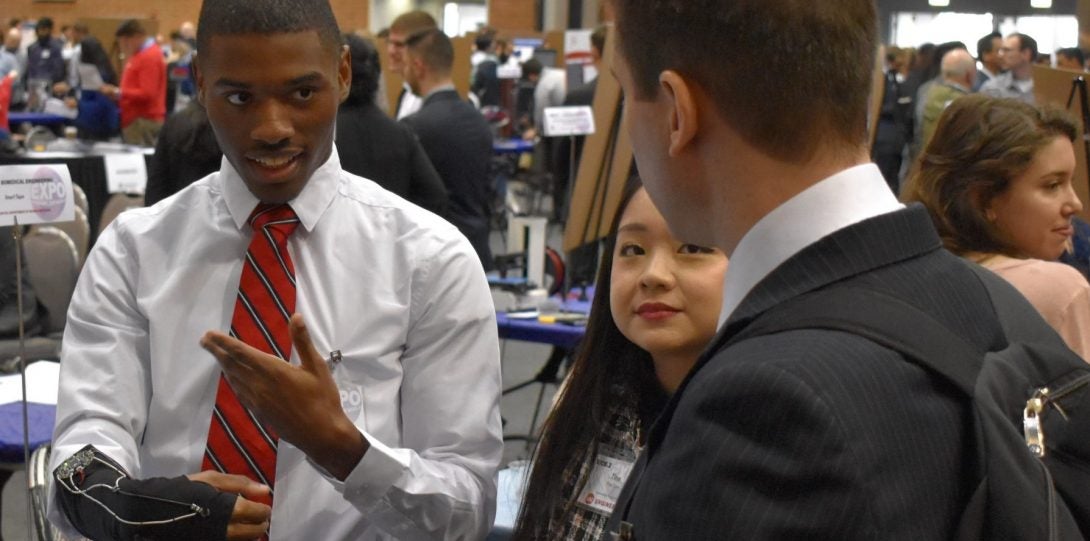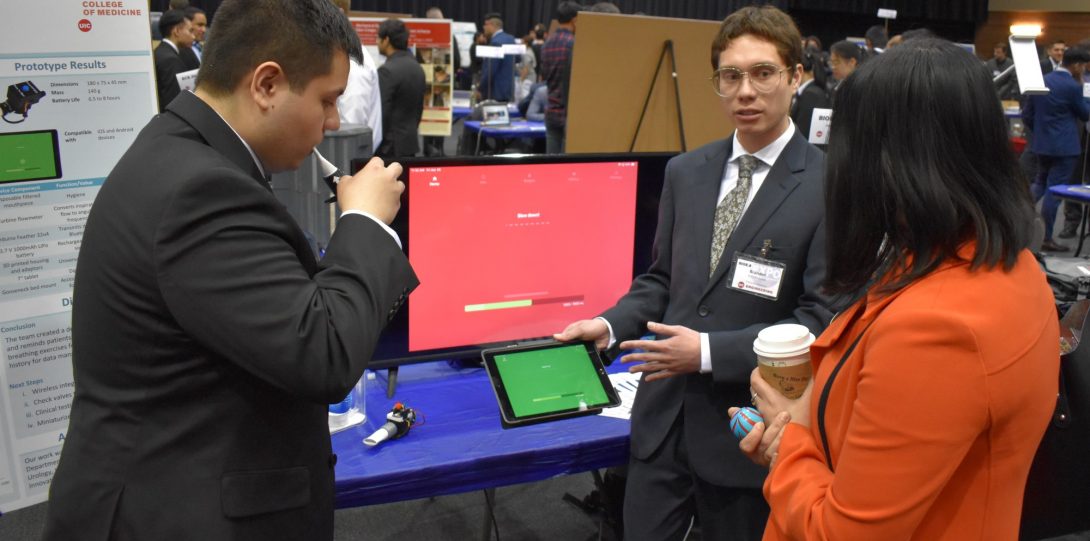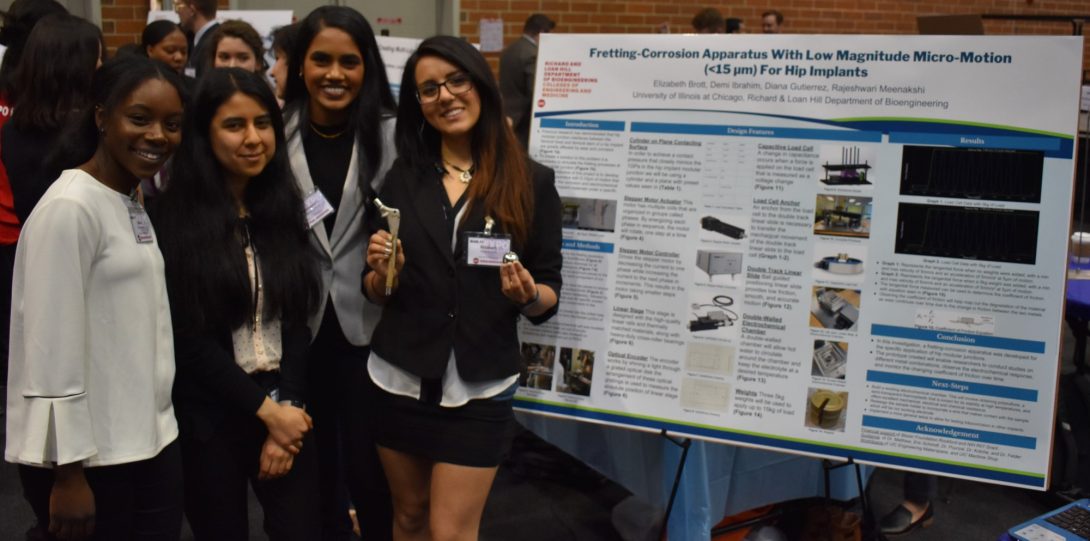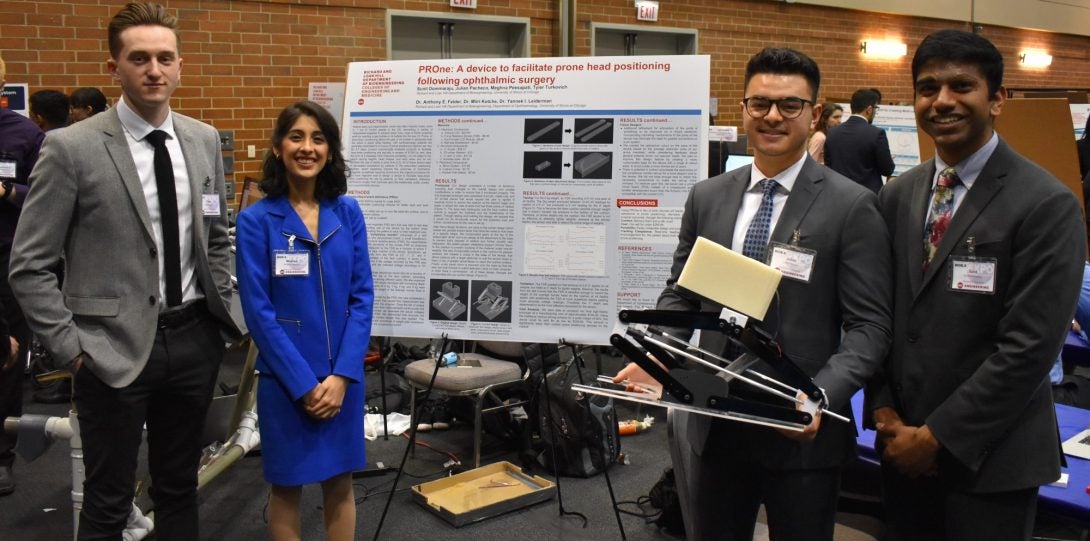Bioengineering students shine at design expo 2019

Bioengineering students shine at Design Expo 2019 Heading link
Dozens of senior UIC bioengineering students capped off months of hard work, along with years of studying in the Richard and Loan Hill Department of Bioengineering, by showcasing their projects at the 30th annual UIC Engineering Design Expo.
The expo, held this year on April 26, featured 16 teams of bioengineering students who impressed attendees and judges with a wide variety of projects and prototypes, including new wearables to prevent injuries and increase mobility for the visually impaired, technology to assist with surgical procedures, smartphone apps to help with eye disorders, and an anatomically accurate 3D printed model of the human spinal cord and surrounding tissue.
The bioengineering students joined with more than 700 college of engineering undergraduates to pack the Isadore and Sadie Dorin Forum in Chicago. The exhibition hall was full of young men and women who were eager to show off their work to the judges and other expo attendees. Each student at the expo completed the two-semester Senior Design Course that challenged them to solve a real-world design problem.
Award winners
Six of the department’s teams were honored with awards from the judges, who represented many different areas of Chicago’s professional community.
The team of Asra Mubeen, Haley Patel, Priyank Patel, and Lauren Rodgers were given the poster award for the bioengineering department for their project “ARMour: Upper Limb Support System for Laparoscopic Procedures.” The students designed a rigid arm support to help cut down on the time it takes to properly prepare patients for laparoscopic procedures to help alleviate operating room delays.
Kholoud Baste, Mary Ann Metzger, and Joe Striblen won the department’s overall prototype award for their “Wearable Assistive Device for the Visually Impaired.” The team noted that despite being almost a century old, the most commonly used tool to help improve the mobility of visual impaired people is still the white cane. To bring this field into the 21st Century, they created a wearable device that can be worn over the user’s clothes and can identify common roadside hazards and use stop signs and street lights to help users navigate intersections and crosswalks.
The team of students, including Nathaniel Jesko, Ben Mcclerklin, Hita Patel, Angelica Smith, and Tina Trinh, won the Biomedical Engineering Award for their “Smart Tape” project. The wearable technology aims to help prevent wrist injuries in tennis players by monitoring a user’s wrist movement during practice and providing immediately feedback if his or her wrist is hyperflexed.
The Clinical Bioengineering Award was taken home by Austin Buen-Gharib, Samantha Labrador, Michael Lukas, and Brandon Lukas for their handheld flow meter SpiroSMART device that they created to help prevent hospital-acquired pneumonia (HAP). The team’s abstract, “Inspired Inspiration to Prevent Hospital-Acquired Pneumonia” noted HAP has a mortality rate of 19 percent and costs hospitals more than $80 million annually. To help combat this problem, the students designed the SpiroSMART incentive spirometer to include reminders, guidance, and feedback to reward slow deep breaths.
Sunil Dommaraju, Julian Pacheco, Meghna Peesapati, and Tyler Turkovich won the Rehabilitation Engineering Award for their project titled “A Device to Facilitate Prone Head Positioning Following Ophthalmic Surgery.” The students designed a table-top device to improve the lives of retinal detachment patients who need to stay face-down for eight to 10 hours a day after surgery. Their device can change heights, allows for users to customize the head angle and back flexion, and comes with a two-panel mirror on the base to allow the user to watch TV or use a laptop.
The Software Engineering I Award went to Gaia Gbola, Kelsey Hughes, Kyle Luciu, and Dominique Stewart for their project titled “WZProtein: A Molecular Visualization Web-Based Platform for Educational and Research Purposes.” The team created a web-based platform to allow students and researchers to view and interact with 3D models of different molecules. The students noted they worked hard to create a service that can be used without the user having to download any software on their end.
By David Brazy, UIC






